|
|
|
|
|
Simple model train block detection circuit for 3-rail track
Use a relay and an insulated section of outside rail to detect electric trains on a three-rail model railroad layout.
|
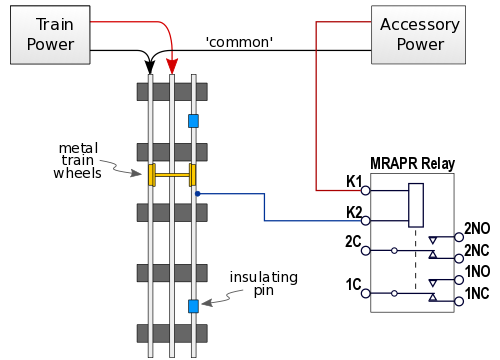
The circuit above shows how to detect a model train in a section of 3-rail track. The section of track is called a 'block,' so this type of circuit is called a 'block detector' or 'block occupancy detector.'
The track block is created by insulating one of the outside rails from the rest of the track. Insert a plastic rail pin at each end of the block, as shown by the blue rectangles. A wire is connected to this isolated rail section.
Note that if the track is the old Lionel type with metal cross ties, the isolated rail also must be insulated from the ties. This is done by gently loosening the rail from each tie, then slipping a thin bit of plastic or paper between the rail and the tie.
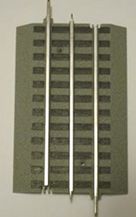
|
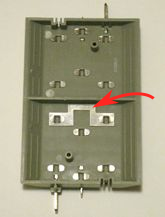
|
|
The red arrow points to the metal strap that electrically connects the two outside rails of this Lionel FasTrack™ section.
|

Lionel tubular track with insulated outside rail.
At each end of an isolated block, replace the metal track pin on the insulated outside rail with a plastic pin.
|
Newer 3-rail track with a plastic base may have the two outside rails electrically connected by a metal strap on the bottom side of the track section. Cut this strap on each section that is part of the isolated block.
Lionel's FasTrack™ line includes 'accessory activation' track sections (#12029 and #12027) that are ready-made with an insulated outer rail and wire connection.
One side of the relay coil (K2) is connected to the insulated rail. The other side of the relay coil (K1) is connected to the output of an accessory power supply. The relay in this example is an Azatrax MRAPR relay, able to operate from AC or DC power supplies.
How it works: Trains designed to operate on three-rail track have metal wheels on metal axles. When such a train is in the insulated track block, the metal wheels and axle create a conducting path from one outside rail to the other. Electric current is able to flow from the accessory power supply, through the relay coil, then back to the accessory power supply by way of the isolated rail, through the metal train wheels, then through the common outside rail.
When the train leaves the block, there is no longer a conducting path from the isolated rail to the common rail. This opens the circuit from the relay coil to the accessory power supply, so the relay turns off.
How the relay works: When current flows through the relay coil (terminals K1 and K2), the contacts 'pick up.' Terminal 1C on the relay will connect to terminal 1NO ('NO' stands for 'Normally Open'). Terminal 2C will be connected to terminal 2NO.
When current stops flowing through the relay coil, the contacts 'drop out'. The relay is said to be 'de-energized.' Terminal 1C will connect to terminal 1NC rather than to terminal 1NO. Likewise, terminal 2C will be disconnected from terminal 2NO and will connect to terminal 2NC ('NC' stands for 'Normally Closed').
The relay contacts can be wired to two separate accessory or signaling circuits, just like push button switches. But instead of being operated manually like a push button, the relay is operated automatically by controlling the current through its coil.
Now add a red/green signal:
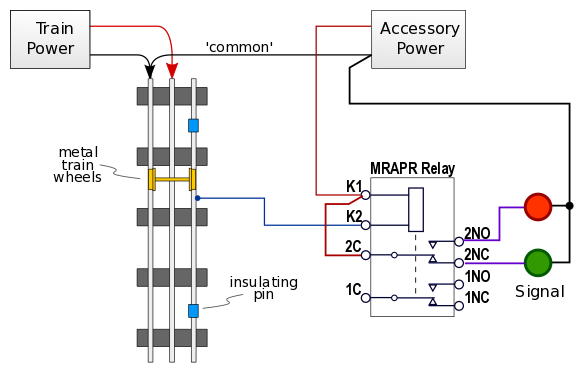 Here we use one of the relay contacts to control a two-color train signal. When a train is in the block the relay will be energized and the '2C' contact connects with the '2NO'
contact. This completes the circuit for the red light, and the signal will show red, indicating the block is occupied.
Here we use one of the relay contacts to control a two-color train signal. When a train is in the block the relay will be energized and the '2C' contact connects with the '2NO'
contact. This completes the circuit for the red light, and the signal will show red, indicating the block is occupied.
When the train leaves the block, the relay is de-energized. The '2C' contact drops down and connects with the '2NC' contact. This turns on the green light, indicating the block is clear.
The accessory power supply must match the coil requirements of the relay. A DC relay will not operate from an AC power supply. The power supply voltage and the voltage rating of the relay coil should be within 20% of each other.
Azatrax MRAPR relays will operate with either AC or DC power.
Wiring MTH RailKing 30-11012 crossing gates and Lionel 6-14098 crossing gates:
These O gauge signals have built-in flasher circuits and gate motors. One relay can control all the signals at the crossing.
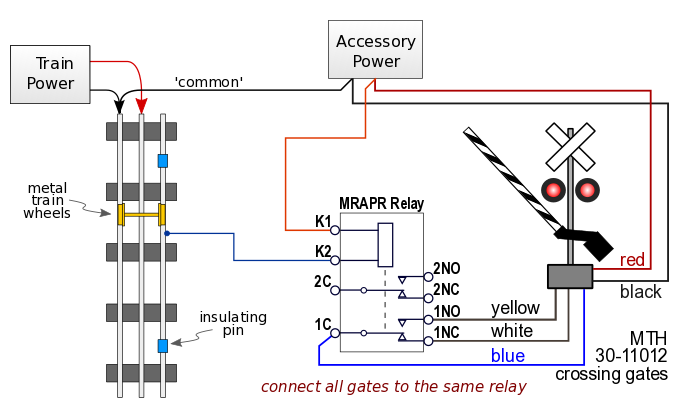
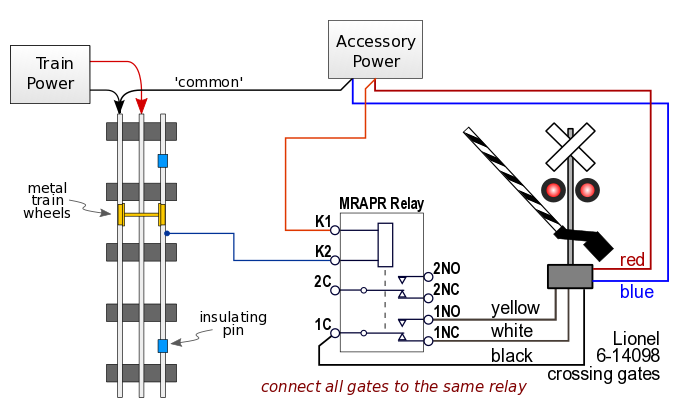
To detect trains without modifying the track: To avoid the hassle of isolating an outside rail, an infrared proximity sensor can be used. These sensors use invisible infrared light to detect a train. Note that an infrared sensor detects a train on a relatively short section of track, whereas an isolated rail can be of any length.
[ Back to Azatrax relay page ] [ Azatrax infrared detectors ]
© copyright 2009-2021 Azatrax LLC, Longmont, Colorado
|
|







